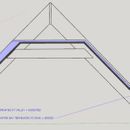Cathedral Ceiling with some bays Vented and some bays Unvented?
Is is possible to insulate a cathedral ceiling with a mixture of vented and unvented rafter bays, depending on whether a given bay terminates at an eave or in a valley?
I would like to insulate our roof and finish our attic. About 2/3 of the bays run from eave to ridge, the other 1/3 terminate in a valley. In the interest in saving foam (and money) I would like to install vent-and-batt assembly in the bays that can be vented, and only do an unvented flash-and-batt assembly in the bays where venting is not possible.
I’m not sure if the attached picture makes the question more clear or less clear, but hopefully it helps somewhat.
Thank you for your help!
GBA Detail Library
A collection of one thousand construction details organized by climate and house part










Replies
Bobb,
Yes that will work fine.
Well, that was much easier than I was expecting (fearing).
Thank you so much for the help, Martin!
Bobb,
To address Bill's concerns, make sure to adhere to the ratios Martin calls out in assembly #5 in this link: https://www.greenbuildingadvisor.com/article/five-cathedral-ceilings-that-work
Note that flash and batt could potentially be a problem in those unvented rafter bays. You need to make sure you have sufficient spray foam for dew point control, and you want that to be closed cell spray foam. Exactly how much spray foam you need for dew point control depends on your climate zone. As long as you put in enough spray foam to keep condensation issues at bay, you're safe filling the remaining space with batts.
I personally would probably fill the remainder of the space with open cell spray foam though, since it's cheaper than a full fill of closed cell spray foam, and it's easier than trying to stuff batts into the irregular spaces that you have after you do a partial fill of closed cell spray foam.
Edit: when I reread that, it occurred to me that what I said might not be entirely clear. When I said “fill the remainder of the space with open cell spray foam”, I meant first apply sufficient closed cell spray for dew point control, then fill the remaining space with open cell cell spray foam and trim it flush. You don’t want to fill the entire cavity with only open cell spray foam.
Bill
Bill and Malcolm --
Thank you for the follow-up! I have read that article, and it is already my plan to maintain an appropriate ratio between closed cell and fiberglass.